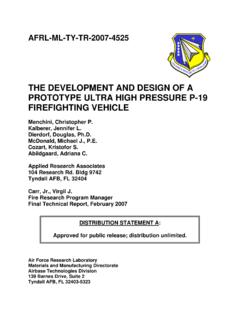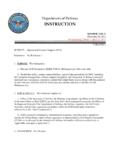Transcription of Joseph T. Leonard, et al Washington, D. C. 12 November 1969
1 AD 698 119 EFFECT OF A STATIC DISSIPATOR ADDITIVE ON THECHARGING TENDENCY OF JET FUELSJ oseph T. Leonard, et alNaval Research LaboratoryWashington, D. November 196910 00* 0*.fibtd. t p:-.:eth ato'*.**.:: 000 0:0: 00:9::0R SEATMN OFlI COMRENtoa Burea ofCH CStandards00. 0000S* 0rhis doumn ha be PRTEN aproe CforC/Nt a public relfs ~f:s KaStatic Dissipatr Adtiv*l We MCivwin Tecndenc-y ofetViJt32P11v T. TIEONAR0D AND HoMERVIW BranchCeh-nistry Divisioni\ow iiher 12, 1969rIAVAI, %,?.ARCH1 LAEORhtTORY,Was~ngkoi, >n jpprovrd for p~4ic r&~vlc an~d Jel; its disnitrion is iiProblem Status iiAuthorization iiINTRODUCTION 1 EXPERIMENTAL PROCEDURE 1 Gravity Method 2 Separometer Method 2 RESULTS AND DISCUSSION 2 Conductivity 2 Charging Tendency 6 Relaxation 11 SUMMARY AND CONCLUSIONS 14 REFERENCES 16I1 ABSTRACTThe effect of a static dissipator additive on the chargingtendency of both JP-4 and JP-5 type jEt fuels was examined atvarious flow velocities on a laboratory scale.
2 For our use, theterm charging tendency refers to the current generated by a givenquantity of fuel when passing through a filter or an insulated sec-tion of piping rather than to the ability of a fuel to produce dan-gerously high potentials when loaded into a tank. It was foundthat when the conductivity of the fuel is increased by the additionof the static dissipator additive, the charging tendency also in-creases, passes through a maximum, and then decreases. Also,at higher flow velocities, there is an overall increase in thecharging tendency of the fuel, and the position of the maximum inthe charging tendency vs conductivity curve shifts to a higherconductivity range.
3 However, since the rate at which the chargeon the fuel dissipates also increases with increasing conductivity,no increasp in electrostatic hazard due to the use of the staticdissipator additive is foreseen during fuel handling operations aslong as the ability of additive-treated fuels to generate charge isrecognized and sufficient time is permitted for the charge to relaxbefore the fuel enters a receiving STATUSThis is an interim report on a continuing Problem C-01-05 Project RR submitted June 24, OF A STATIC DISSIPATOR ADDITIVE ON THECHARGING TENDENCY OF JET FUELSINTRODUCTIONH ydrocarbon liquids such as jet fuels and motor and aviation gasolines can generatesufficient electrostatic charge when flowing through the pipes and filters of a modernfuel handling system to produce electrical discharges when the liquids are loaded intoreceiving tanks (1-5).
4 Fortunately these discharges seldcm lead to ignitions, but therehave been occasions in which fires and explosiors, attributable to static electricity gen-erated by the fuel, have occurred during the loading of tank trucks (6) and aircraft (7).One way of reducing the danger of electrostatic discharges during fuel handling is bythe use of a static dissipator additive to raise the conductivity of the fuel and therebypromote the rapid dissipation of the charge (7). Indeed one such additive, Shell ASA-3(Shell Oil Company), is currently available and has already gained acceptance outside ofthe United States (8).
5 Some 87 airlines have agreed to accept jet fuel containing thestatic dissipator additive, which is now available throughout Canada and at some 30 in-ternational airports scattered around the world. The additive is not being used in thiscountry mainly: (a) because of the low incidence of electrostatic ignitions during fuelhandling operations in the United States, and (b) because of the adverse effect that someconsider the additive to have on the water separation characteristics of the fuel. How-ever, American authorities are keenly aware of the electrostatic problem and appear tohave taken the position that the additive is available for use if the need should of the possibility that a requirement for the use of the static dissipator ad-ditive could develop on short notice, it is advisable that the individuals making decisionsabout the additive's use have an understanding of the additive itself and how it affects theproperties of the fuel and the operation of the aircraft.
6 Considerable information on thissubject has already been published (7). However, one of the problems which has not yetbeen thoroughly investigated is the effect of the additive on the charging tendency of jetfuel. Shafer, et al. (9), have examined the effect of a commercial static dissipator addi-tive on the charging tendency of naptha in a system which employed stacked paper filterelements. In the present report, the charging tendency of both JP-4 and 3P-5 fuels,which had been treated with Shell ASA-3, was studied in an apparatus containing the sametype of fiber glass filter used in many military and commercial filter/separator PROCEDUREThe fuels used in this study (Table 1) were specification grade JP-4 and JP-5 conductivities of these samples, as measured by Shell charged-ball method (10), areabout average for jet fuels delivered to aircraft (11).
7 The static dissipator additive, Shell ASA-3, is a mixture consisting of equal parts of(a) the chromium salts of mono and dialkylsalicylic acids, (b) calcium aerosol OT (dode-cyl suifosuccinate), and (c) a 50-percent concentrate, in hydrocarbon solvent, of the co-polymer of Laurylmethacrylate and methylvinylpyrldine (8).2 LEONARD AND CARHARTT able IFuels Used in StudyFuel Sample Water Sepnrometer ConductivityType Designation Index Modified(WSIM)(CUI-1mhc)JP-4 J-334 96 J-436 96 were prepared by adding the appropriate amount of ASA-3 to the fuel andshaking for I/2 hour on an Eberbach shaker.
8 The additive-treated fuel was stored inmetal containers for 2 days before any measurements were charging tendency was determined by two separate methoda: gravity MethodA 1-liter sample of fuel was allowed to flow from a reservoir through a metal tubeand filter and into a tank. The total charge transferred, or the streaming current devel-oped during the passage of the fuel through the apparatus, was used as a measure of thecharging tendency. Details of this procedure and a description of the apparatus are givenin Ref.
9 MethodSince the water separometer (13) provides a convenient means of handling smallquantities of fuel under a variety of flow conditions which approximate those encounteredin practice, this device was modified, as shown in Fig. 1, to permit the measurement ofcharging tendency of fuels at various flow velocities. The modifications include the useof Teflon tubing to electrically isolate the coalescer cell (filter), removal of the waterfall-out chamber, and the addition of an electrometer to measure the current generatedby pumping fuel through the cell.
10 As in similar experiments (12), a single coarse-bondedfiber glass filter was used in the coalescer cell. The procedure consisted of recordingthe filter current at 30-second intervals as a one-liter sample was pumped through AND DISCUSSIONC onductivityThe effect of the static dissipator additive on the conductivity of the two jet fuels isshown in Fig. 2. Fuel conductivity is expressed in conductivity units ( ), where1 = 10-1 4 mho/cm. Although the sample of the JP-4 used in this study was muchmore responsive to the static dissipator additive than the JP-5 sample, there is no rea-son to assume that all JP-4 fuels behave in this manner.













